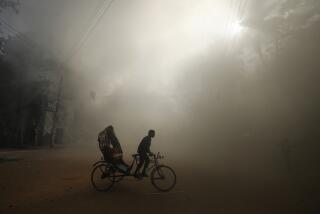30,000 Anti-Communists March as Belgrade Turmoil Intensifies
BELGRADE, Yugoslavia — Political turmoil intensified in the Yugoslav capital Monday as more than 30,000 anti-Communist demonstrators flooded central streets after Serbian authorities were forced to relax a police siege.
Workers angered by an acute and worsening economic crisis joined thousands of students who had battled with police overnight to shout their opposition to Serbia’s hard-line leadership.
The unrest that shows no sign of abating has put up a fierce challenge to the rule of Communist President Slobodan Milosevic, who won a landslide re-election victory only three months ago.
But Milosevic and his party wooed voters with promises of stability and prosperity, which has led to widening discontent as industrial output and living conditions have plunged in Yugoslavia’s largest republic.
The Serbian Parliament, in which Communists hold 194 of the 250 seats, met in emergency session late Monday, and dozens of speeches condemning the violence droned on through the night.
While the session promised to consider protesters’ demands for an easing of Communist controls on the mass media and release of more than 200 people jailed over the weekend, it may have been aimed at dragging out the confrontation so as to defuse it.
Milosevic blamed “foreign elements” for instigating the weekend violence, and other Communist leaders warned of fascist plots to destabilize the republic.
Tanjug, the official Yugoslav news agency, reported that Parliament was considering a bill that would grant Milosevic the power to declare a state of emergency.
Opposition political leaders warned after their defeat in December that civil unrest would spread as the severity of Serbia’s economic crisis became clear. But few expected such a sudden change of public sentiment toward the Communist leadership, one of the last orthodox regimes in Eastern Europe.
The revolutionary fervor that has spread through Serbian opposition circles since Saturday has evoked the atmosphere of the 1989 popular uprisings that swept Communist dictators out of most of Eastern Europe.
However, it was not clear whether the disenchantment extends beyond the capital and other major Serbian cities to the traditional Communist strongholds of the peasantry and blue-collar workers.
Some factory workers joined students and intellectuals in the daylong protest Monday, which might indicate a further erosion of support for the ruling party.
Several thousand anti-government demonstrators were still occupying Belgrade’s central Terazija Square at midnight Monday, chanting denunciations of the Milosevic leadership and singing 1960s-era peace songs among piles of rubbish that have amassed during the three-day protest.
“Belgrade has awakened!” demonstrators declared. They also likened Milosevic to dictators Josef Stalin and Saddam Hussein.
Police and emergency vehicles stood watch at a respectful distance.
In an attempt at a show of strength, the Serbian Communists, who now call themselves the Socialist Party, staged a rival demonstration near party headquarters, at the confluence of the Sava and Danube rivers. Many of the 20,000 participants had been bused in from nearby factories.
Federal army tanks and troops were summoned to quell anti-government rioting that broke out Saturday when Serbian police and paramilitary forces charged more than 30,000 demonstrators who had gathered in Republic Square to demand an end to Communist manipulation of the mass media.
Two were killed and more than 100 were injured in that fighting.
When the federal troops withdrew Sunday evening, thousands of students angered by the harsh crackdown marched against the police, demanding the release of the more than 200 arrested the previous day. Police fired tear gas and attempted to disperse the crowds with baton charges.
Sensing the mounting public resentment of what was a virtual police siege of Belgrade, which is both the federal and Serbian capital, the Serbian Interior Ministry eased the security presence and allowed peaceful demonstrators to remain on the streets.
Police sealed off the central streets when the crowd swelled to more than 30,000.
There were also mass student demonstrations in Novi Sad, about 40 miles north of Belgrade, and in the southern city of Nis.
Free-lance journalist Michael Montgomery contributed to this report.
More to Read
Sign up for Essential California
The most important California stories and recommendations in your inbox every morning.
You may occasionally receive promotional content from the Los Angeles Times.











